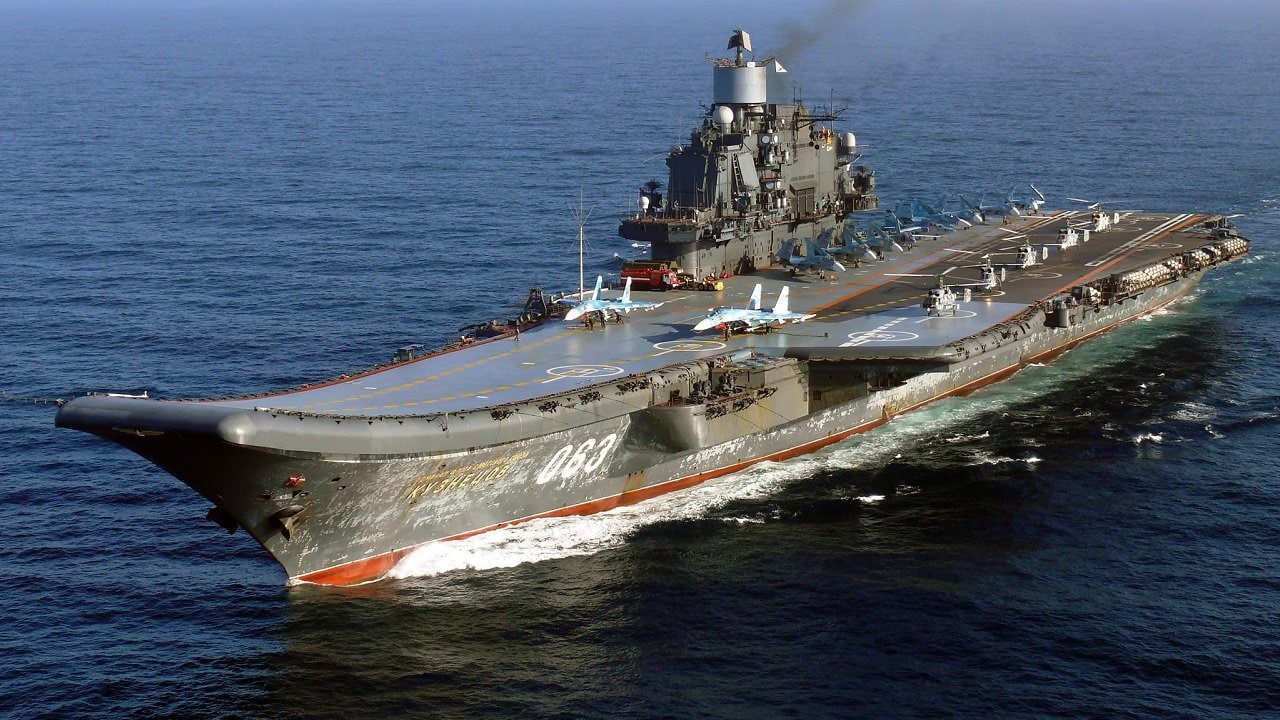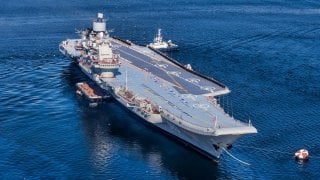Russia's Admiral Kuznetsov Aircraft Carrier Is Clearly A Rusty Failure
Russia's Admiral Kuznetsov, its only aircraft carrier, has faced numerous setbacks, from catastrophic mishaps to underwhelming performance, casting doubts on its future utility.
Summary: Russia's Admiral Kuznetsov, its only aircraft carrier, has faced numerous setbacks, from catastrophic mishaps to underwhelming performance, casting doubts on its future utility. Initially launched during the late Soviet era, Kuznetsov's operational life has been plagued by accidents, including fighter jet crashes and damaging fires. Its singular deployment to Syria highlighted its inadequacies, with significant aircraft losses and mechanical failures. Despite Russian assertions of imminent re-commissioning, the carrier's history of misfortune and operational challenges suggest it might be more beneficial for Moscow to consider decommissioning the Kuznetsov, as its prospects for meaningful service appear bleak.
Admiral Kuznetsov: The Troubled Journey of Russia's Sole Aircraft Carrier
Russia’s sole aircraft carrier should be relegated to the scrapyard. For years, Admiral Kuznetsov has been dry docked undergoing frequent repairs. The ship’s history is marred with unfortunate events, causing some to refer to the carrier as a complete failure. From abysmal deployment performance to fire outbreaks and falling cranes, bad luck just seems to engulf the Kuznetsov. Russia’s carrier has remained out of service since 2017, however, state-run news outlets allege that Kuznetsov could re-commission with the fleet by the end of this year. Considering the ship’s history and Moscow’s tendency to over-exaggerate, this timeline seems murky at best.
The History of Russia's Admiral Kuznetsov Aircraft Carrier :
During the Cold War, Admiral Kuznetsov was designed to serve as the lead ship of the two-ship Admiral Kuznetsov class in the Soviet Navy. By the time the Soviet Union collapsed, however, the second planned ship- Varyag- was not fully constructed. Ultimately, Ukraine sold this incomplete carrier to China and it was commissioned as the People’s Liberation Army’s Liaoning. The carrier was built within the Ukrainian Soviet Socialist Republic at Chernomorskiy Shipyard during the late 1980’s to early 1990’s. Initially, the carrier was named Riga, which was eventually changed to Leonid Brezhnev and later Tbilisi. It was not until 1990 that the ship was designated Admiral Flota Sovetskogo Soyuza N.G. Kuznetsov (shortened to Admiral Kuznetsov.
Specs & Capabilities
Admiral Kuznetsov has at least two dozen rotary-style vertical launch systems, with eight missile cells each. According to The Drive, these systems could potentially fire 192 SA-N-9 “Gauntlet” point air defense missiles, which would be instrumental in defending the carrier against anti-ship missiles, aircraft, and surface ships in wartime. Additionally, Russia’s sole carrier is fitted with several anti-submarine defenses with two UDAV-1 anti-submarine/anti-torpedo rocket systems.
While Western ships developed around this time typically used gas turbines or nuclear power for energy, Kuznetsov was conventionally powered by mazut. This fuel source is notoriously black and tarry, giving off a heavy and visible trail of dark smoke when used. For an aircraft carrier, this fuel source is subprime, considering enemy warships can view the mazut from miles away. To make matters worse, mazut is a particularly challenging fuel source that requires proper boiler and piping installations to ensure adequate preheating and pressurization. When the Kuznetsov was constructed, however, insufficient piping incorporated on the ship made it challenging for its boilers to operate at full capacity simultaneously.
In addition to its shoddy construction and difficult power source, the carrier has underperformed in its intended role. Over Kuznetsov's 30-year career, it has only been deployed one time. In 2015, Russia deployed its sole carrier to the Syrian coast as part of the Kremlin’s campaign in support of the government forces in the civil war. During this operation, both a MiG-29 and an Su-33 fighter jet were lost.
As detailed by USNI News, “A fighter assigned to the Russian carrier operating in the Eastern Mediterranean crashed during a landing approach on Sunday. The Mikoyan MiG-29K was part of a trio of MiGs that had sortied from Russian carrier Admiral Kuznetsov headed over Syria. At one point, for unknown reasons, one of the fighters turned back to the carrier and crashed while on approach to the carrier, the official said.”
Russian state-run media outlets also verified these claims, asserting that a “technical fault during the approach landing” was to blame for the two losses.
Following these mishaps, the rest of the airframes positioned on the carrier were moved to an airbase in Syria, essentially rendering the presence of the ship useless. This incident appeared to be the first of many unfortunate mishaps that would plague the aircraft carrier. In 2018, a floating crane fell onto the carrier’s deck, killing one worker and injuring several others. Since the crane opened up a 200-square-foot hole in the flight deck, it took some time for the wreckage to be cleared. While waiting to be delivered to dry dock, another incident occurred.

A fire caused by a welding error in the ship’s engine room killed two workers and injured more than a dozen others. Overall, the repair bill for this mishap alone ballooned to roughly $8 million. Kuznetsov has not been impervious to additional incidents since being relegated to dry dock, however.
In 2022, another fire erupted onboard. Alexei Rakhmanov, head of the United Shipbuilding Corporation, said that "All the relevant fire systems worked normally. There was no damage and no casualties.”

While the Kremlin claims that Kuznetsov will re-enter service with its naval fleet sometime this year, the prospects for this remain dim. In fact, Moscow may want to consider scrapping its sole carrier altogether.
About the Author: Maya Carlin
Maya Carlin, National Security Writer with The National Interest, is an analyst with the Center for Security Policy and a former Anna Sobol Levy Fellow at IDC Herzliya in Israel. She has by-lines in many publications, including The National Interest, Jerusalem Post, and Times of Israel. You can follow her on Twitter: @MayaCarlin.


